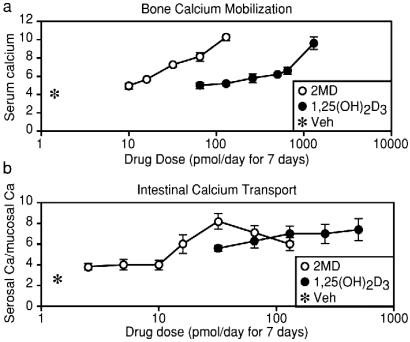Figure 1.
Weanling male rats were obtained from the low-vitamin D colony of Harlan–Sprague–Dawley and housed in overhanging wire cages in a vivarium provided with a 12-h light/12-h dark cycle. The fluorescent lighting was shielded to block UV light. Animals were fed a purified 0.47% calcium, 0.3% phosphorus vitamin D-deficient diet as described by Suda et al. (8) ad libitum for 1 week and then the same diet containing 0.02% calcium and 0.3% phosphorus diet for 3 weeks. During the final week, the indicated doses of either 1,25(OH)2D3 or 2MD (6) were delivered in 0.1 ml of propylene glycol/ethanol (95:5) i.p. each day for 7 days. Control animals received vehicle. (a) Twenty-four hours after the final dose, animals were killed by decapitation and blood was taken to determine serum calcium levels (mg/dl). (b) The first 10 cm of duodenum was used to determine intestinal calcium transport by the everted sac technique as described (8). Each group contained at least five animals, and the values represent the mean ± SEM.

